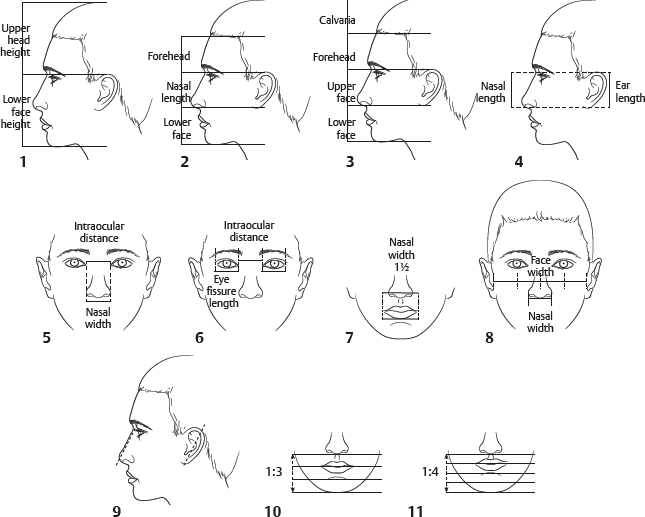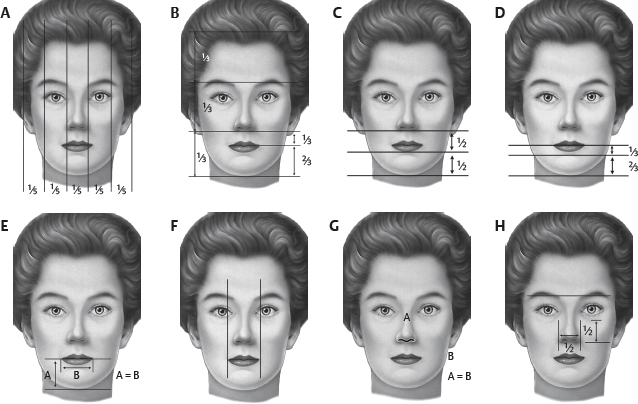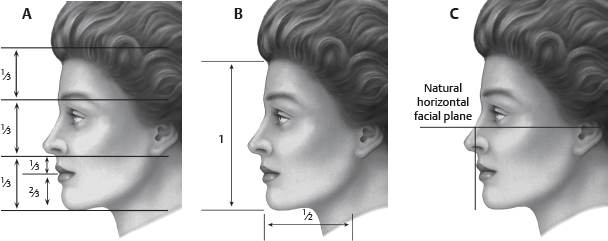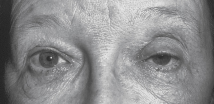31. Facial Analysis
Janae L. Kittinger, Raman C. Mahabir
SKIN QUALITY1,2
■ Skin type and complexion
• Fitzpatrick classification: Ranks the skin’s tendency to tan or burn after actinic exposure (Table 31-1)
Table 31-1 Fitzpatrick Skin Type Classification
| Skin Type | Sun Exposure History/Skin Color |
| I | Never tans; burns easily and severely; extremely fair skin |
| II | Usually burns; tans minimally |
| III | Burns moderately; tans moderately |
| IV | Tans moderately and easily; burns minimally |
| V | Rarely burns; dark brown skin |
| VI | Never burns; dark brown or black skin |
■ Skin texture and thickness
• Total dermal thickness decreases approximately 6% per decade.
• Actinic exposure and smoking increase the rate of dermal deterioration.
■ Photoaging
• Glogau classification: Ranks the degree of skin wrinkling and severity of photoaging (Table 31-2)
Table 31-2 Glogau Classification
| Photoaging Group | Degree of Skin Wrinkling and Photoaging |
| I Mild (age 28-35) | Little wrinkling or scarring; no keratosis; requires little or no makeup |
| II Moderate (age 35-50) | Early wrinkling, mild scarring; sallow color with early actinic keratosis; requires little makeup |
| III Advanced (age 50-65) | Persistent wrinkling; discoloration with telangiectasias and actinic keratosis; wears makeup always |
| IV Severe (age 60-75) | Wrinkling; photoaging: gravitational, dynamic; actinic keratosis with or without skin cancer; wears makeup with poor coverage |
■ Severity of facial rhytids
• Classification of rhytids
► Grade I: No rhytids at rest or on animation
► Grade II: Superficial rhytids on animation only
► Grade III: Deep rhytids on animation only
► Grade IV: Superficial rhytids at rest, deep on animation
► Grade V: Deep rhytids at rest, deeper on animation
FACIAL CANONS OF DIVINE PROPORTION3
Classical Greek canons of proportion were formulated and documented by the Renaissance artists. These neoclassical canons are as follows (Fig. 31-1):

Fig. 31-1 Neoclassical canons. 1, The head can be divided into equal halves at a horizontal line through the eyes. 2, The face can be divided into equal thirds, with the nose occupying the middle third. 3, The head can be divided into equal quarters, with the middle quarters being the forehead and nose. 4, The length of the ear is equal to the length of the nose. 5, The distance between the eyes is equal to the width of the nose. 6, The distance between the eyes is equal to the width of each eye (the face width can be divided into equal fifths). 7, The width of the mouth is 1½ times the width of the nose. 8, The width of the nose is one fourth the width of the face. 9, The nasal bridge inclination is the same as the ear inclination. 10, The lower face can be divided into equal thirds. 11, The lower face can be divided into equal quarters.
■ The head can be divided into equal halves by a horizontal line through the eyes.
■ The face can be divided into equal thirds, with the nose occupying the middle third.
■ The head can be divided into equal quarters, with the middle quarters being the forehead and nose.
■ The length of the ear is equal to the length of the nose.
■ The distance between the eyes is equal to the width of the nose.
■ The distance between the eyes is equal to the width of each eye. (The face width can be divided into equal fifths.)
■ The width of the mouth is 1½ times the width of the nose.
■ The width of the nose is a fourth the width of the face.
■ The nasal bridge inclination is the same as the ear inclination.
■ The lower face can be divided into equal thirds.
■ The lower face can be divided into equal quarters.
TIP: The golden ratio of Fibonacci (1:1.618) is a common theme seen throughout facial aesthetics.
FRONTAL VIEW4
■ Vertical fifths: Lines drawn adjacent to the most lateral projection of the head, the lateral canthi, and the medial canthi (Fig. 31-2, A)

Fig. 31-2 A, Vertical fifths. B, Horizontal thirds. C, Division of the lower third. D, 1:2 ratio of the lower third. E, Stomion to menton (A) and the width of the mouth (B) are equidistant. F, Distance between the medial limbi approximates the width of the mouth. G, Width of the face at the malar level (A) is equal to the distance from the brow to the menton (B). H, Infraorbital rim to base of nose length is equal to the nasal base length, which is equal to half the length of the middle third of the face.
■ Horizontal thirds: Lines drawn adjacent to the menton, nasal base, brows at the supraorbital notch level, and hairline
• The lower third can be divided into an upper third and lower two thirds by a line drawn through the oral commissures (Fig. 31-2, B)
• The lower third can be divided into halves by a horizontal line adjacent to the lowest point of the lower lip vermilion (Fig. 31-2, C)
■ Horizontal line through the labiomental groove divides the stomion-to-menton distance into a 1:2 ratio (Fig. 31-2, D)
■ Width of the mouth and the stomion-to-menton distance are equal (Fig. 31-2, E)
■ Width of the mouth approximates the distance between the medial limbi of the corneas (Fig. 31-2, F)
■ The width of the face at the malar level is equal to the distance from the brows to the menton (Fig. 31-2, G)
■ The distance from the infraorbital rim to the base of the nose equals the nasal base length, which is equal to half of the length of the middle third of the face (Fig. 31-2, H)
LATERAL VIEW4
■ The face profile can be divided into horizontal thirds.
• The lower third can be divided into an upper third and lower two thirds by a line drawn through the oral commissure (Fig. 31-3, A)

Fig. 31-3 A, Horizontal thirds. B, Distance from the mandibular angle to menton is half the distance from the hairline to the menton. C, Desired lip-chin complex relationship.
■ The distance from the mandibular angle to the menton is half the distance from the hairline to the menton (Fig. 31-3, B)
■ The desired lip-chin complex relationship is an upper lip that projects ~2 mm more than the lower lip (Fig. 31-3, C)
• In women the chin lies slightly posterior to the lower lip.
• In men the chin is slightly stronger.
REGION-SPECIFIC ANALYSIS
Analysis of the region starts with the upper third, then goes to the middle third, then finally the lower third.
UPPER THIRD
Forehead1
■ Assess for proportion and contour.
■ Forehead height: Measure from hairline to midpupil (fixed point rather than hairline to brow).
■ Assess for both active and passive frontalis (transverse) forehead rhytids.
■ Assess for both active and passive corrugator (vertical) and procerus (horizontal) rhytids at the glabella.
■ Brow position
• Assess for compensated brow ptosis. (The brow is ptotic but compensated for by frontalis hyperactivity.)
• Assess the medial and lateral brow position and the relationship of the brow to the upper lid.
► With lid closed, the brow should be 2-2.5 cm above the upper lid margin.
► At midpupil, the ratio of the aperture of the eye (1) to the distance from brow to lash line (1.618) is consistent with the golden ratio.
► Highest portion should be at (or just lateral to) the lateral third point, corresponding to lateral edge of the limbus in straight gaze.
► The medial portion of the brow should be caudal to the lateral portion.
► Greatest degree of brow descent often occurs at the lateral orbit (lateral brow hooding).
Upper Eyelid1
■ Assess for redundant skin, skin quality, fat herniation, and soft tissue excess (subcutaneous fat, preseptal fat, lacrimal gland ptosis).
■ Intercanthal distance is 31-33 mm; however, 33-36 mm can be considered attractive.
■ Intercanthal axis is normally tilted slightly upward from medial to lateral. (Lateral canthus is 2 degrees higher.)
■ Vertical opening is ~10 mm.
■ Lid position
• Upper lid extends down at least 1.5 mm below the upper limbus but no more than 3 mm.
• Pretarsal skin is visualized on relaxed forward gaze: 3-6 mm (varies with ethnicity).
• The distance from the lower edge of the eyebrow to the open lid center margin should never be less than three times the measurement of the visualized pretarsal skin.
■ Supratarsal fold
• 7-11 mm from lash line
• Indicator of levator dehiscence: Elevation of supratarsal fold; accentuated supratarsal hollow5 (Fig. 31-4)






